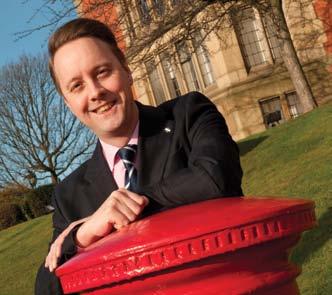
29 minute read
A bigger and better Union
A new entrance for the Students’ Union is a dramatic addition to this well-loved building. Visitors now enter a light-filled, double-height atrium space, which provides a real ‘wow’ factor. This latest development was ready to welcome students at the beginning of the 2010 academic year.
“I am very grateful to t he Univers ity for t heir
Advertisement
commitment to the student experience,” said Union President Josh Forstenzer, “which is illustrated by their funding of this landmark new space for students.” Vice-Chancellor Professor Keith Burnett commented, “The new refurbishment of the Students’ Union is a demonstration of the University’s commitment to providing our students with the very best facilities, to ensure they have a first-class University experience.”
The new look entrance opens out into the Activities and Sports Zone – the one-stop student activities resource centre, and starting point for information about sports clubs, societies, Give it a Go and SheffieldVolunteering – which also received funding from the Alumni Fund and the University of Sheffield in America Alumni Fund. The atrium also now links the Students’ Union building with University House more effectively. In addition, the Union shop has been enlarged and new eateries included in the layout.
The Students’ Union has continued to receive national recognition for their achievements during 2010–11. In addition to its ranking as the top students’ union in the Times Higher Education Student Experience Survey, the Union is only the second in the country to receive a Gold Award in the national Student Union Evaluation Initiative. In their review, the audit team highlighted the positive comments they received from all students they interviewed at Sheffield.
www.sheffieldstudentsunion.com
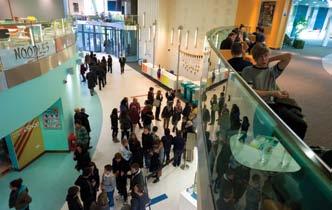
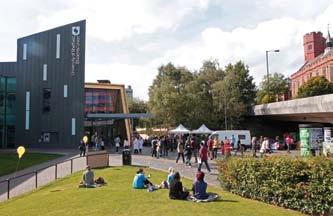
Opposite: The new entrance to the Students’ Union. Abovefromtop:Inside the new atrium; a view of the Union across the concourse.
A tale of two presidents
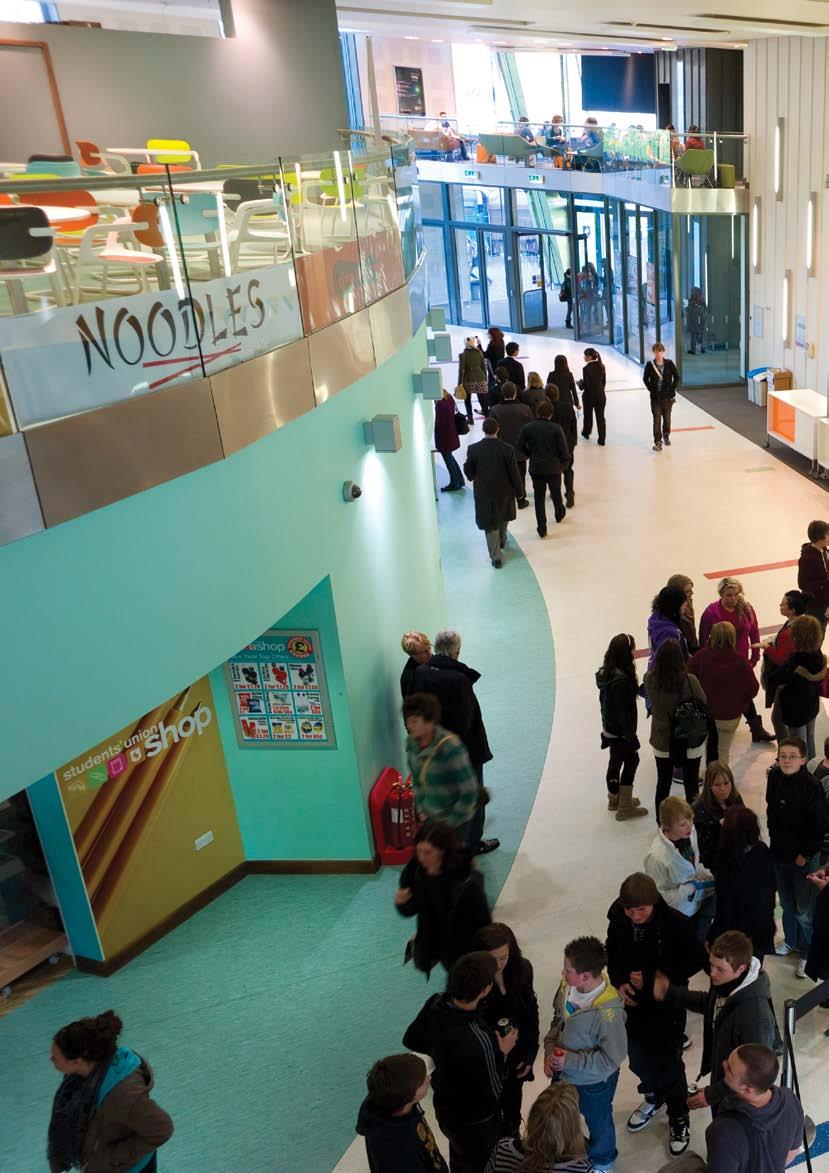
We invited former Union President Andrew Palazzo (BSc Biochemistry 1979) to visit the Union and meet the current President, Josh Forstenzer (BA Politics and Philosophy 2006, MA Political Theory 2007). Their discussion highlighted the contrasts between the role of a students’ union in the 1970s and today.
Andrew Palazzo There were two big differences between the 1970s and now. One is cross-generational respect. I think this is much greater now, in terms of willingness within the Union to accept that people in the University are sufficiently competent. We felt that the University didn’t see the world as we did; there were many academics who saw students as a necessary inconvenience. The second difference is the financial one. Now if you want to go to university, you have to finance yourself. I’m one of seven children who went to university and we were all eligible for full student grants. We had greater financial independence and with that came personal freedom. We confronted the University – to us, the University implemented and represented government policy and we held them responsible for it.
Josh Forstenzer The Union is a charity, just like the University, and we have strict rules that we have to work within. In terms of our relationship with the University, we play the role of critical friend. In your day, you fought against bigger boundaries – today we are more elaborate in the ways in which we push. On the big issues, like funding, I put a lot of blame on your generation and the Thatcher years. Now, the system in Britain links education to economic output, rather than education for its own sake and self discovery.
AP: The University experience has changed very substantially. We produced an alternative prospectus to tell prospective students what we felt to be truthful about departments and the academic staff. Now, you have a common purpose I don’t think we had at that time. When you come into the Union now, it is a massive commercial operation. My generation lived in the Union, and it was nothing like as splendid. The Union wasn’t as big a selling point then. Now, you are giving a student experience that the University cannot give itself. It is difficult to see how you can be in opposition to each other.
University of Sheffield: total number of students 1978 –79 7,418 2010 –11 24,916
JF: Legislation makes it difficult for us to campaign on party political issues; we have to be so specific, so targeted. There is definitely a growth in student activism following the 2010 General Election; I’ve been here for eight years and the mood has really changed. We can express views on many things but we can only campaign on issues that affect students as students. So we have to be very careful.
AP: But now you are listened to. However, my time marked the beginning of the change from the Union being an organisation for students run by students into one that said there are more important things we should be doing. We had committee meetings that decided the colour of the paint on the walls. Students did absolutely everything – it was mad! We started the process to ‘professionalise’ the Union. I’m also proud that the students of the 1970s successfully lobbied for the creation of the Nursery [the Nursery is now jointly run by the University and the Union] and also for a counselling service, which were both major achievements for the University as a whole.
JF: The main theme of my presidency has been the promotion of widening participation, making it an institutional priority. I’ve also been deeply involved in Project 2012 [the University’s response to the new funding regime which lays out clearly the value of what Sheffield offers to its students], advocating an increase in outreach spending and bursaries. We led a huge campaign called ‘Cuts are Nuts’, which was the largest students’ union campaign in the country, organised in response to the government’s proposals to cut higher education funding and lift the cap on fees. I believe there has been a shift in gear – in previous years, the Union, as an organisation, had forgotten how to campaign at that level. And our national campaigning is also helping us locally; as we develop relationships with local MPs, we gain a more even footing with the leaders of the University.
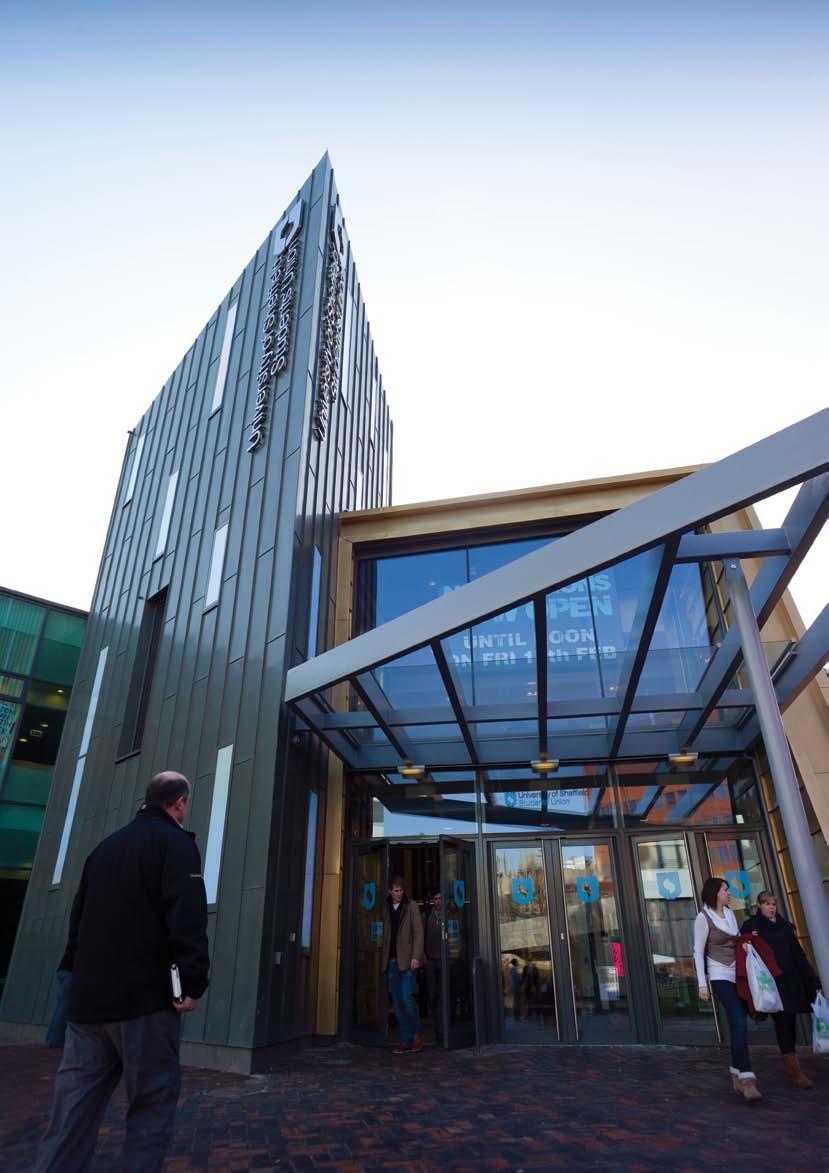
AP: This is the politics of participation. I was engaged in a period of opposition. We were living in a still industrialised Britain. Students thought of themselves as being part of the trade union movement. The period between 1974 to the turn of the decade was difficult for relationships between students and universities across the country, not just Sheffield. However, anti-apartheid and anti-racism activism were particularly strong, and I can see our Who's who Union Treasurer 1979–80. He grew up in the East End of London: “The most important thing was to have the independence that university gave. Choosing a university then was very hit and miss – you just had the prospectuses to help you make up your mind. I got involved with the Students’ Union as it gave you the opportunity to develop skills outside your experience.” He came north to study in Sheffield: “I fell in love with the city. I would also have loved to benefit from the opportunities offered now by the Students’ Union and the fabulous Information Commons.”
Andrew went on to train as a solicitor after spending a year as a research officer at the National Union of Students: “The Union at Sheffield made me unemployable; I’d been given so much responsibility that it made it very difficult for me to move into work, being told what to do!” He is now Practice Director
Josh Forstenzer and Andrew Palazzo

legacy now with greater diversity in universities. Things have changed massively for the better. We struggled for change – but our tactics weren’t the most sophisticated. But it’s not to say that all students felt that way; there was a strong group who didn’t take a radical view.
JF: I think the current student population at Sheffield generally feels that careful consideration and collective decisions are the way forward. I think that’s really reflected in the elected student representatives and particularly the sabbatical officers of recent years. Our strength is that 80 per cent of students are seriously engaged with the Union. The Union gives them the space to create something out of nothing; they have a major role in making things happen that would not happen
Andrew Pala zzo was Unio n Pres ident 1977 –78 and
otherwise, through societies, committees and volunteering. of McCormacks Law, one of London’s leading criminal law defence firms. His wife, Linda Miller (BSc Biochemistry 1978), was Union President 1978–79.
Jos h Forste nzer was a PhD stu dent in t he
Philosophy Department before his term of office as Union President in 2010–11; he will return to his studies later this year. He was born in the USA and grew up in France: “I thought I would follow in my father’s footsteps and study at Stanford but soon realised how expensive it would be! So I looked at universities in the UK as this was a much cheaper option.” Josh came to Sheffield as an international student in 2003 as it had excellent departments in both Politics and Philosophy. He had also heard good reports of the Students’ Union and the quality of life in the city.
Exploring the diverse group of people associated with the University of Sheffield
A lifelong fascination
The first perso n to intro duce mosqu itoes into
a laboratory at the University, Professor Janet Hemingway (BSc Genetics 1978, Hon DSc 2009) is now Director of the Liverpool School of Tropical Medicine (LSTM). A centre of excellence in tropical international health, LSTM has been engaged in the fight against infectious, debilitating and disabling diseases for over 100 years.
A clash with a head mistress who believed that girls didn’t do science led Janet to take an odd mix of A levels – Biology, Chemistry and Religious Studies. Not the most promising set of qualifications for a genetics degree. Luckily, Sheffield allowed her “in by the back door” as the Head of Genetics, Professor Alan Roper, advised her to apply for zoology and then switch after the first year if she displayed any aptitude. “The small Genetics Department at Sheffield was where I was most at home,” she explained, “and I remained fascinated by the subject as classical genetics rapidly morphed into molecular biology. For my final-year project, it struck me that mosquitoes rather than the fruit fly might be a much more fulfilling subject. My tutors were supportive as long as I arranged access to all the mosquito material.
“The fun bit was bringing in the mosquitoes – nobody in Sheffield had ever worked with a mosquito and certainly had no idea how to raise them. The occasional hungry stray escaped and either bit the staff and students or, as the species Anopheles and Aedes are dawn or dusk feeders, they bit the cleaners on the early morning shift. The arrival of the larger Toxorhynchites caused a stir and the cleaners decided that I would have to clean the lab myself. No end of telling them that Toxorhynchites didn’t bite could persuade them otherwise. The project set off a lifelong fascination with mosquitoes.”
During the final phase of her PhD (taken at the London School of Hygiene and Tropical Medicine), Janet spent a month in Sri Lanka and saw the enormous need for better malaria control on Honours the the ground, and the lack of direct impact that any form of research publication had on this or the people struggling to contain and treat malaria. She said, “The next 25 years have really followed this trajectory, so that today I have two jobs – one running the LSTM of around 600 people, with an annual £55 million budget, and the other running the world’s only product development partnership (PDP) for vector control products – the Innovative Vector Control Consortium (IVCC) – with a $228 million budget over nine years, predominantly supported by the Bill & Melinda Gates Foundation.
“Having the Foundation active in this area has emphasised to other donors and governments the discrepancy of the funding base for these neglected diseases. For example, it is a sad reflection that the global value of insect control for golf greens is substantially larger than the market for malaria mosquito control. IVCC has demonstrated that the PDP business model is effective in unlocking the latent enthusiasm of our partners in both the global pest control industry and research institutions for development of new public health insecticides.”

Fellow
Ho norary of t he Royal
Fellow of soc iety
t he Amer
, 2011
ica n Soc iety for Micro biology
, 2011
Fore ign Assoc
of Science , one
iate
of
of
the
t he Nat
highest
io nal
scientific
Aca demy
honours in Professor Janet Hemingway US, 2010
Ho norary Fellow of t he Royal College of Phys
icians, 2008
Fellow
Merseys
Wels of t he Aca demy of Medical Sciences
ide Woma
h Woma n of n of t he Year
t he Year
2000 2003 , 2006
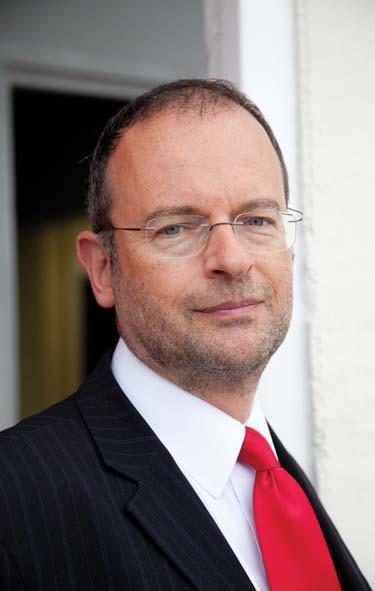
Our alumni:
members of parliament 2010
Life as an MP is a significa nt co ntrast to Paul 's
time at the University, where he was in charge of an organisation with 900 staff and an annual turnover of £11 million. Now, with the support of a small staff team, he represents almost 100,000 people across Sheffield and is quick to point out: “It is a great honour to represent a constituency which covers the heart of the city, with a hugely diverse population.”
Paul joined the Students’ Union in 1978 as a research officer on a two-year contract. He liked it so much he stayed, taking on a number of roles before becoming General Manager in 2003, following John Windle. “The Union is now widely recognised as the UK’s leading students’ union and has played an increasingly central role in the life of the University. While always providing an independent voice for students, our partnership with the University was an important part of our success.”
Active in local politics throughout his time at the University, Paul was selected as the Labour candidate for Sheffield Central in February 2008; the constituency includes both of the city’s universities, with around 20 per cent of the electorate being students. “Back in 1978, universities could exist in isolation, but not now. I believe that the future of Sheffield revolves around the
Rt Hon Kevin Barron
(studied Economics and Social History 1979), Rother Valley (Labour)
Jake Berry(BA Law 2000), Rossendale and Darwen (Conservative)
Rt Hon David Blunkett (BA Politics 1972), Sheffield, Brightside and Hillsborough (Labour)
Anne Main (Cert Education 1979), St Albans (Conservative)
Graham Stringer (BSc Chemistry 1971), Blackley and Broughton (Labour)
Paul Blomfield MP
A voice for
Familiar to many across the University community from his time as General Manager of the Students’ Union, Paul Blomfield has been the Member of Parliament for Sheffield Central since May 2010.
Sheffield combination of traditional skills and expertise in industry with the innovation and research of its universities. This gives the city a unique opportunity.”
Paul is able to bring his experience of higher education to bear in his role in Parliament. He is Secretary of the All Party Parliamentary Group on Universities, sits on the Business, Skills and Innovation Select Committee and has been deeply involved in the debate on the funding of universities. He is also the Parliamentary Private Secretary to Hilary Benn, the Shadow Leader of the House of Commons.
“It is an extraordinary privilege to be speaking up for my city, but it has its frustrating moments – it took six hours of bobbing up and down to catch the Speaker’s eye before I was called to deliver my maiden speech. I receive anything up to 200 emails and letters a day, seeking my support on an incredibly wide range of issues. My office team are fantastic in making sure I can respond effectively. Confidence in MPs was eroded following the expenses scandal, so I spend as much time as I can meeting people, and working to build trust in democratic politics.”
www.paulblomfield.co.uk
The passionate volunteer
Volu nteer ing is an integral part of Rac hel Colley ’s l ife . The
History graduate (BA 2010) joined the Activities and Events Committee in her first year, leading to a prominent role in SheffieldVolunteering during the remainder of her degree. Rachel’s dedication was recognised by her peers when she was named Student Unionist of the Year in the National Union of Students’ Awards 2010.
Rachel was elected as Communities Liaison on the Volunteering Committee in 2009, as well as being on the SheffieldVolunteering Board. She was Raising and Giving (RAG) Publicity Officer before her election to RAG Chair in her final year. She said, “We donate 85 per cent of RAG money to local charities – Sheffield is where we live for at least three years and you have an opportunity to see where the money goes and how it is used.” Towards the end of her second year, Rachel decided that she wanted to do something more; the following year, she successfully stood for election as Activities Officer 2010-11. Her passion for student activities and societies shone through and she was a popular winner.
Rachel commented, “It’s been such an honour to work with the other sabbaticals this year. We’ve bonded over issues like the fees campaign and worked successfully as a team. I’m going to miss all the people in the Union and their dedication. You never have a typical day in this role – it’s so exciting and diverse. It’s been a brilliant journey, and I’m going to cry a lot when I leave!”
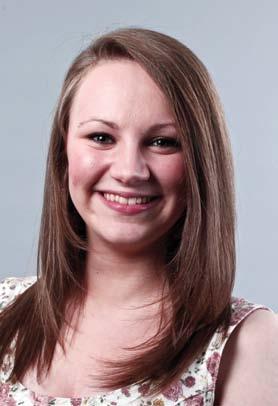
Rachel Colley
Professor Joy Stackhouse
Meeting the challenge
Speec h and la nguage t hera py
was the perfect career choice for Professor Joy Stackhouse as it combined her loves of science, drama and teaching: “When the ability to communicate does not develop or is taken away it can be devastating for all involved. Working to support clients, their families and teachers is a rewarding occupation and certainly one in which you never get bored!”
Joy has just finished a second term as Head of the University’s Department of Human Communication Sciences (HCS). It was during her first period in office, in 2000–05, that she contacted Miles Stevenson, Director of Development, to discuss fundraising for work with children and adults with communication difficulties: “When it was decided to make the Centenary Tall Ship Challenge a sponsored voyage, the committee focused on helping socially disadvantaged children in Sheffield and also children with cleft palate, both key research and teaching areas for us in HCS.”
The Challenge attracted 48 alumni, staff and students to take part in an exhilarating week-long voyage around the Balearic Islands in April 2005. They raised over £32,000 in sponsorship. Joy explained, “The funds have allowed a number of projects to happen right across the school years. The first involved working with staff and parents in 12 schools in a socially disadvantaged area of Sheffield to promote the language and communication skills of their nursery and receptionage children. The second focused on therapy for children with cleft palate and persisting speech difficulties. Current Tall Ship projects include examining schools’ experience of working with children and parents from Romany, Gypsy and Traveller backgrounds, and the communication and literacy skills of disadvantaged teenagers and young offenders.
“I hope that the alumni who took part in the Challenge feel really satisfied with their fundraising efforts. HCS was represented on the voyage by Dr Judy Clegg who has maintained a key role throughout. Another key person was our patron Vanessa Lawrence CB (BA Geography 1984, Hon DSc 2001) of Ordnance Survey. She said to ‘aim high’ and we tripled the initial sponsorship amount and have added to it subsequently. Working with my Tall Ship HCS colleagues, Miles Stevenson and our collaborators in education, health and social services has certainly been a highlight of my time at Sheffield.”
Find out more about the Tall Ship projects at www.sheffield. ac.uk/hcs/about/tall_ship
Tinkering away

Tim Key
Tim Key ( BA Russ ian Stu dies 2000 ) has teame d up
with a string quartet to create an album – initially on vinyl, though now also available as a CD – of his poetry, set to music. And it was recorded on a boat. Helpfully, it is called Tim Key. With a String Quartet. On a Boat. The review in the NME concluded: “If you haven’t chucked your entire speaker system through the bay windows by track five, then his words will never leave you.” Tim seems equally ambivalent about his appeal as a performer: “Some people really like it. Some people really don’t. So the people who like it try to find me live and the people who don’t, know not to bother.”
The Drama Studio became very familiar to Tim during his time at the University and he successfully auditioned for The Birthday Party and Rosencrantz and Guildenstern Are Dead. “That was a great experience,” he said. “I was a bit of a square in my first year as I studied hard to learn Russian, but I was quite open minded and wanted to do something else as well.” Tim spent some time teaching English in Kiev during his gap year, and then again in his year abroad in St Petersburg, and toyed with returning to Russia once he graduated (with a First). However, a chance audition for a pantomime with the Cambridge Footlights led to his first performance at the Edinburgh Fringe in 2001. It was at that point that he began to write sketches – fantastic preparation for further Edinburgh shows, and television and radio appearances. The poems came later. He started writing them five years ago, filling up little notepads.
Those who have seen Tim as resident poet on BBC Four’s Newswipe with Charlie Brooker will know what to expect. His quirky mix of poetry, performance art and film struck the right note with the judges of the Edinburgh Comedy Awards 2009 as his show The Slutcracker took the top prize. “The win meant that the show had an afterlife,” he explained. “I’ve performed it in Sydney, Melbourne and Montreal, finishing my latest tour at the Lyric, Shaftesbury Avenue. I’ve also performed it at the Crucible in Sheffield. It takes time to get established – you build up a following and momentum. I keep on trying to be creative, keep it interesting, and I’ve managed to turn a hobby into a job.”
Follow Tim on Twitter: @timkeyperson
Barry gets his kicks
A love of t he wide o pen spaces and desert
regions of the southern United States has led Barry Orr MBE (BEng Mechanical Engineering 1952) to undertake a series of epic motorcycle rides, covering thousands of miles – and all since his retirement in 1994. He used his first motorcycle – a 350cc Royal Enfield – to travel to and from the University as “it was all I could afford.” Now, Barry is the proud owner of 15 classic motorcycles, which he displays at home and regularly rides. His ‘shopping bike’ is a 1999 Heritage Softail Classic Harley.
Barry achieved his long-held ambition of riding Route 66 in 2003, at the age of 74. The highway stretches 2,448 miles from Chicago, Illinois, to Santa Monica on the Pacific coast. Barry rode a second-hand Harley that he bought in Texas (where he still stores it in between trips) and travelled with two friends. Unfortunately, Barry’s euphoria at finishing the 11-day ride was curtailed by an accident he had in Los Angeles at rush hour. He skidded on gravel and came off his bike, skinning his hands and legs and suffering a massive haematoma on his left hip. The police shut the six-lane Interstate down within a few minutes so an ambulance could reach him; he allowed the paramedics to patch him up before heading off again – on the bike. A few days later he rode the remaining 2,500 miles back to Texas, following the Mexican border.
Barry returned to the US last year to attend the Sturgis Motorcycle Rally in the Black Hills of South Dakota, which attracted 850,000 bikers. He rode 1,650 miles from Texas in 110 degrees heat, travelling part of the way with a group of Vietnam veterans, to meet up with friends he had met on the Route 66 trip. On his second day at the rally, gravel caused another dramatic accident, which resulted in 24 stitches in his right knee, a dislocated shoulder and fractured shoulder blade. Needless to say, Barry was back on his bike for the ride back to Texas after four days as a pillion passenger – a very painful journey!
Now 82, Barry is planning his next ride, which will take in the Hoover Dam, Mammoth Lakes, Yosemite National Park and the Pacific Coast Highway; a “relaxing”, three-week, 5,500-mile tour. And he is finally considering the purchase of a trike and bringing his beloved Texan Harley home to his collection in South Yorkshire.
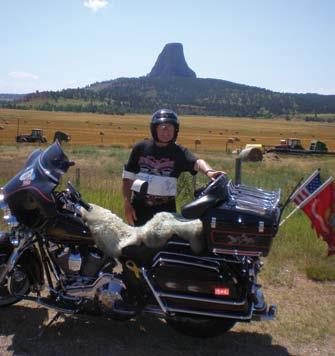
Barry Orr takes a break from riding pillion in Wyoming, with the Devil's Tower in the background.
Reflecting history
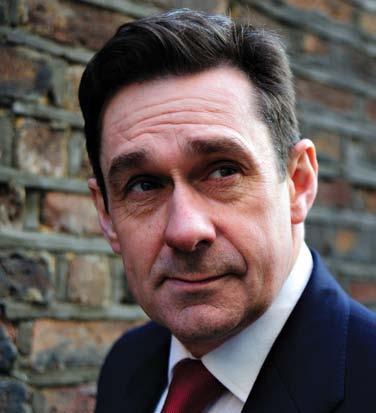
Paul Mason (BA Music and Politics 1981) is the Economics Editor of Newsnight, the BBC’s flagship news programme.
What are the highlights of your time at Sheffield?
The fun started in the second year when I got involved in student politics and got dragged into supporting the steelworkers’ strike. I was at Hadfield’s on 14 February 1980 at 5am. Look it up. The ultimate highlight was sitting in the Hallamshire House pub, having a heated ‘studenty’ conversation about Marxism when a 90-year-old guy in a flat cap turned round and said: “No, the dictatorship of the proletariat is not the goal; the goal is the negation of the negation”. He’d been a communist in the engineering industry in 1919.
Why did you make the switch from music to economics’ journalism?
I’d written quite a bit of neo-romantic ‘classical’ music but all that was getting performed were fairly schmaltzy bits distilled into popular musical theatre. I moved to London to try and break into writing – I mentioned to somebody that I was working on
A signed copy of Paul Mason’s latest book Meltdown: The End of the Age of Greed
Answer the following question:
Which magazine did Paul work for before joining Newsnight?
Email your answer to alumni@sheffield.ac.uk, citing ‘Newsnight competition’ in the Subject line.
Deadline: 28 October 2011 We will inform the lucky winner by email.
Paul Mason
an opera based on the movie Gilda and as a result I still have a cherished fax from Columbia Pictures ordering me to stop. At this point I realised the teaching jobs I was doing to pay the rent had taken over my life. So I went into page design and sub-editing. Suddenly I was in a world I liked and it liked me, as the saying goes.
And then what prompted the move from print to broadcast journalism?
Quite simply, I applied for a job and they accepted me. As deputy editor of Computer Weekly, we were doing a lot of exposés that were getting us on TV. I think Newsnight picked the most unorthodox person they could find in the sheaf of applications.
Can you remember your first appearance on Newsnight?
My first live appearance was on 11 September 2001. Hard to forget. I was stoked with adrenaline but the strangest thing was that – because the BBC had only offered me a three-month contract – I hadn’t bothered telling some of my friends. So it was a bit of a surprise for them to have me pop up in what must have been the most-watched edition of Newsnight of the decade, analysing the ability of the world economy to survive the shock. “Two weeks ago you were writing about Microsoft SQL Server and now you’re covering Armageddon,” one former colleague emailed me.
What do you enjoy most about the job?
Covering action, as it happens. It’s not exactly the stock in trade of a programme like Newsnight but when you find yourself in the middle of a total political and environmental disaster like Hurricane Katrina, or standing outside Lehman Brothers in New York on the day people leave with the contents of their desks in cardboard boxes, you can at least say you’ve had a go at writing the first draft of history.
And what would you like to be doing in five years’ time?
Covering free, multi-party elections in China.
Follow Paul on Twitter: @paulmasonnews
Here we focus on three members of staff who have recently retired.
Dr Martyn Whyte
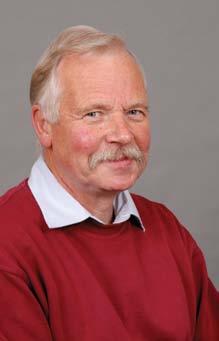
Dr Martyn Whyte
Dinosaur footprint expert Dr Martyn Whyte joined the then Department of Geology in 1974, moving to the Unit of Earth Sciences in 1990, and finally Geography in 2001 when the subjects merged. He ran the Natural Environmental Science undergraduate programme for a number of years. He continues his research and is the lead member of the Sorby Geology Group.
While Dr Whyte’s retirement means that Geography no longer has staff left from Geology, geological themes still run strongly through teaching and research. Chris Clark is the latest Sorby Professor of Geoscience, and students are exposed to sediment-related field skills and taught how geology, landscape and society interact through Environmental Issues and Management modules. Geoscience is alive and well within Geography.
www.sorbygeology. group.shef.ac.uk
Emeritus Professor Bryan Lawson
After qualifying as an architect, Emeritus Professor Bryan Lawson completed a PhD in Psychology, which equipped him for essential research both into how buildings work and how designers go about conceiving them. He joined the University as a lecturer in 1974 where, as an early pioneer of computer-aided design, he developed the Gable system. He progressed to a Chair and appointment as Director of Research by 1985 and took on the Headship of the School of Architecture in 1991. He held this position for eight years, instigating a new emphasis on research which resulted in success in the national Research Assessment Exercise. He was also active in University affairs, becoming Dean of the Faculty of Architectural Studies and serving on many committees.
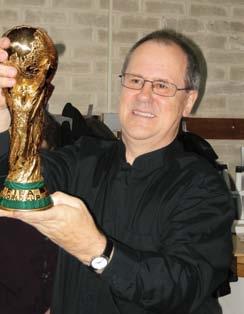
Football fan Professor Bryan Lawson at his retirement party.
Emeritus Professor Gerald Newton
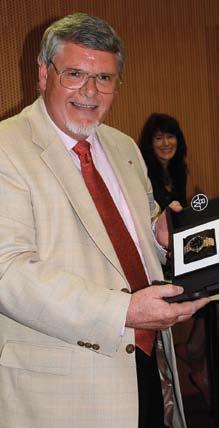
Emeritus Professor Gerald Newton has retired after 39 years as a member of staff of the Department of Germanic Studies. Professor Newton has researched Luxembourgish and Luxembourg since 1968, and is the leading British scholar in this field.
He established the Centre for Luxembourg Studies at the University in 1995, and was appointed a Commandeur de l'Ordre de Mérite du Grand-Duché de Luxembourg in 1999. The department organised a Luxembourg Studies Symposium in Professor Newton’s honour in July 2010.
Professor Gerald Newton
Dr Kristine Horner is the new Director of the Centre for Luxembourg Studies; she is developing the provision of Luxembourgish at undergraduate and postgraduate level and would like to get in touch with alumni who studied the subject at the University. Please contact her by emailing
k.horner@sheffield.ac.uk.
Honours and awards
Staff and students from the University continue to be recognised nationally and internationally for their expertise.
Professor Mike Hounslow, Pro-Vice-Chancellor for the Faculty of Engineering, was elected a Fellow of the Royal Academy of Engineering.
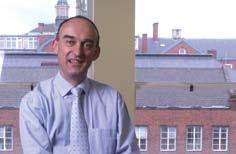

Professor Mike Hounslow
Adrian Allen (Advanced Manufacturing Research Centre), Professor Chris Franklin (Dentistry) and Emeritus Professor Geof Tomlinson (Mechanical Engineering) were awarded OBEs in the New Year’s Honours list.
Professors Paul Brakefield (Animal and Plant Sciences) and Peter Horton (Molecular Biology and Biotechnology) were elected Fellows of the Royal Society.
Mr Jim Catto (Oncology) was awarded the European Association of Urology’s Crystal Matula Award, which is given to the most promising European urologist under the age of 40.
Dr Andrew Chantry (Medical School) was awarded the Research Medal Award for Haematology by the Royal College of Pathologists.
The Film Unit was named Best Student Society by the British Federation of Film Societies.
Dr Pen Rashbass’ winning photo, Going home.

Dr Pen Rashbass (Biomedical Science) won BBC One’s Countryfile photographic competition; her image features in the programme’s 2011 calendar. Benjamin Hennig, a PhD student (Geography), was selected by the Institute of Public Policy Research North to feature on their list of the 50 brightest and most talented people in Northern England.
Human Resources and Student Services won their respective categories at the Times Higher Education Leadership and Management Awards.
Christopher Jesson (BA Urban Studies and Planning 2010), now a Master’s student (Town and Regional Planning), received the Chancellor’s Medal 2010 for his work campaigning for students with disabilities at the University.
Professor Mahdi Mahfouf and Dr Moulmoud Denai (Automatic Control and Systems Engineering) received the top prize at the Medipex NHS Innovation Awards Ceremony.
A team including Professor Noel Sharkey (Computer Science) received the Royal Academy of Engineering Rooke Medal for their Walking with Robots project.
Shane Smith, a Law and Criminology student who volunteers as a special constable, was named Special of the Year for his work with Greater Manchester Police’s Bolton division.
Professor Paul Speight (Dentistry) appears in the 2011 edition of Who’s Who.
Qi Wang, a PhD student (Electronic and Electrical Engineering), was awarded one of only 35 Chinese Government Awards for Outstanding Chinese Students Abroad.
Professor Georgina Waylen
Emeritus Professor Peter Hannon
(Education) and Professors Peter Marsh (Sociological Studies), Paschal Sheeran (Psychology), Georgina Waylen (Politics) and Paul White, Pro-Vice-Chancellor for Learning and Teaching, received the title of Academician from the Academy of Social Sciences.
Samantha Warrington, a postgraduate student (Biomedical Science), won the ‘close-up category’ in the Society of Biology’s photographic competition for her picture of an embryo of a fruit fly.
The refurbished Western Bank Library received the Renovation Award at the Sheffield Design Awards ceremony hosted by Sheffield Civic Trust.
Professor Peter Willett (Information Studies) received the Patterson-Crane Award of the Dayton and Columbus Sections of the American Chemical Society for his work in the field of chemical information.
Emeritus Professor Peter Wright
(Materials Science and Engineering) received the Galileo Galilei Award for Energy Conversion by Ion Induction at the 12th International Symposium on Polymer Electrolytes.
Professor Will Zimmerman (Chemical and Biological Engineering) received the Brian Mercer Award for Innovation from the Royal Society for his work creating a new device for the energy-efficient production of alternative biofuels.

